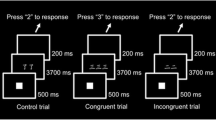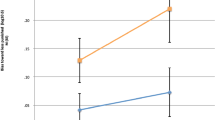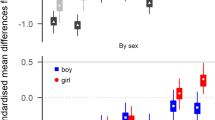Abstract
This experiment was designed to investigate the hypothesized distractibility of hyperactive children in a focused attention task. Distractibility was defined in terms of Shiffrin and Schneider's model of focused attention as the ability to ignore irrelevant in favor of relevant information. Failure to inhibit processing of irrelevant information indicates a focused attention deficit. Task efficiency in all children decreased when irrelevant information was presented. The mean reaction time, within-subject variance of reaction time, and error percentage all increased compared with a nondistraction condition. Thus, the demands of focused attention, as formulated in the model, were measured optimally. Since hyperactives and controls did not differ significantly with respect to task efficiency in the distraction condition, a focused attention deficit in hyperactives was not demonstrated. The hyperactives did nevertheless make more errors and their responding was more variable than the controls. However, the difference in error percentages between hyperactives and controls was associated with the difference in IQ. It is speculated that the variable responding in hyperactives is caused by a less optimal state of performance unrelated to distractibility.
Similar content being viewed by others
References
Browning, R. M. (1967). Effects of irrelevant peripheral visual stimuli in minimally brain damaged children.Journal of Consulting Psychology, 31, 371–376.
Campbell, S. B., Endman, M. W., & Bernfeld, G. (1977). A three-year follow-up of hyperactive preschoolers into elementary school.Journal of Child Psychology and Psychiatry, 18, 239–250.
Douglas, V. I. (1983). Attentional and cognitive problems. In M. Rutter (Ed.),Developmental neuropsychiatry (pp. 280–329). New York: Guilford Press.
Grünewald-Zuberbier, E., Grünewald, G., & Rasche, A. (1975). Hyperactive behavior and EEG arousal reactions in children.Electroencephalography and Clinical Neurophysiology, 38, 149–159.
Lachman, R., Lachman, J. L., & Butterfield, E. C. (1979).Cognitive psychology and information processing: An introduction. Hillsdale, NJ: Erlbaum.
Lorch, P. E., & Horn, D. G. (1986). Habituation of attention to irrelevant stimuli in elementary school children.Journal of Experimental Child Psychology, 41, 184–197.
Radosh, A., & Gittelman, R. (1981). The effect of appealing distractors on the performance of hyperactive children.Journal of Abnormal Child Psychology, 9, 179–189.
Rosenthal, H. R., & Allen, T. W. (1978). An examination of attention, arousal and learning dysfunction of hyperkinetic children.Psychological Bulletin, 85, 689–715.
Rosenthal, H. R., & Allen, T. W. (1980). Intratask distractibility in hyperkinetic and nonhyperkinetic children.Journal of Abnormal Child Psychology, 8, 175–187.
Schneider, W., & Shiffrin, R. M.(1977). Controlled and automatic human information processing: I. Detection, search and attention.Psychological Review, 84, 1–66.
Sergeant, J. A., & Scholten, C. A. (1983). A stages of information approach to hyperactivity.Journal of Child Psychology and Psychiatry, 24, 49–60.
Sergeant, J. A., & Scholten, C. A. (1985a). On resource strategy limitations in hyperactivity: Cognitive impulsivity reconsidered.Journal of Child Psychology and Psychiatry, 26, 97–110.
Sergeant, J. A., & Scholten, C. A. (1985b). On data limitations in hyperactivity.Journal of Child Psychology and Psychiatry, 26, 111–124.
Sergeant, J. A., & van der Meere, J. J. (1988). What happens after a hyperactive commits an error.Psychiatry Research, 24, 157–164.
Sergeant, J. A., van Velthoven, R., & Virginia, A. (1979). Hyperactivity, impulsivity and reflectivity: An examination of their relationship and implications for clinical child psychology.Journal of Child Psychology and Psychiatry, 20, 47–60.
Shiffrin, R. M., & Schneider, W. (1977). Controlled and automatic human information processing-II. Perceptual and learning, automatic attending and a general theory.Psychological Review, 84, 127–190.
Sternberg, S. (1975). Memory scanning: New findings and current controversies.Quarterly Journal of Experimental Psychology, 27, 1–32.
van der Meere, J. J., & Sergeant, J. A. (1987). A divided attention experiment with pervasively hyperactive children.Journal of Abnormal Child Psychology, 15, 379–391.
van der Meere, J. J., & Sergeant, J. A. (1988). Acquisition of attention skill in pervasively hyperactive children.Journal of Child Psychology and Psychiatry, 29, 301–310.
Zentall, S. S. (1975). Optimal stimulation as theoretical basis of hyperactivity.American Journal of Orthopsychiatry, 4, 549–653.
Zentall, S. S. (1985). Stimulus-controlled factors in search performance of hyperactive children.Journal of Learning Disabilities, 18, 480–485.
Zentall, S. S., & Zentall, T. R. (1983). Optimal stimulation: A model of disordered activity and performance in normal and deviant children.Psychological Bulletin, 94, 446–471.
Zentall, S. S., Zentall, T. R., & Barack, R. B. (1978). Distraction as a function of within-task stimulation for hyperactive and normal children.Journal of Learning Disabilities, 11, 13–21.
Author information
Authors and Affiliations
Additional information
The authors wish to thank L. Leertouwer for making the drawings. This research was supported by grants from the Netherlands Foundation for the Advancement of Pure Research (ZWO) and the Professor Duijker Fund.
Rights and permissions
About this article
Cite this article
van der Meere, J., Sergeant, J. Focused attention in pervasively hyperactive children. J Abnorm Child Psychol 16, 627–639 (1988). https://doi.org/10.1007/BF00913474
Revised:
Issue Date:
DOI: https://doi.org/10.1007/BF00913474




